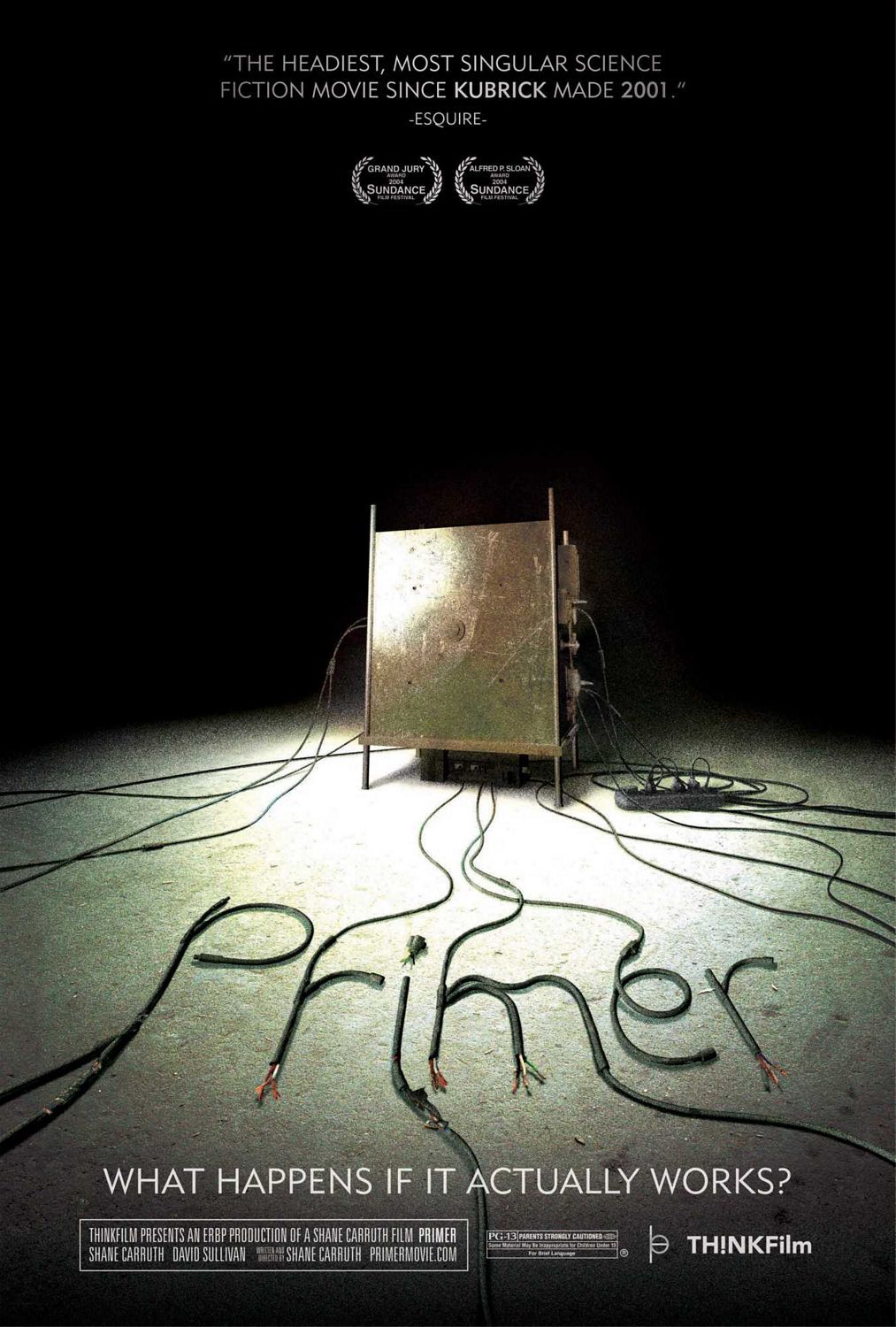The Big Picture
-
Primer
, created on a budget of $7,000, became a cult classic and won multiple awards. - The film’s complex plot, lack of exposition, and fast-paced editing can make it difficult to follow and understand.
-
Primer
‘s low budget contributes to its realistic feel, making it relatable and believable for viewers.
If ever a film were brought into existence through the sheer force of one man’s will, 2004’s Primer is it. Over the course of three years, creator Shane Carruth (who was in his late 20s at the inception) wrote, directed, produced, edited, starred in, and wrote the score for the incredibly innovative, super-grounded sci-fi, all on a budget of $7,000. Primer would go on to win the Sundance Grand Jury Prize and Alfred P. Sloan Prize and become a beloved sci-fi cult classic.
Primer is the story of Aaron (Carruth) and Abe (David Sullivan), two engineers who accidentally stumble onto time travel while working on other projects in Aaron’s garage. The time machine itself is a simple, cramped box made mostly of PVC — no shiny DeLorean, no dimension-hopping T.A.R.D.I.S. — but what makes this version of time travel unique is that in order to travel back in time, the traveler must spend an equivalent amount of time inside the box. In other words, to travel six hours into the past, you must spend six hours in the box.
Immediately after their discovery, Aaron and Abe are ultra careful not to influence the past during their brief trips through time, fearing consequences they can’t even guess at. But eventually, the temptation to change history becomes too great, and Aaron in particular becomes obsessed with his ability to dictate the outcomes of events. This creates multiple complex, interwoven timelines and ultimately leads to a rift between the two characters.

Primer
Four friends/fledgling entrepreneurs, knowing that there’s something bigger and more innovative than the different error-checking devices they’ve built, wrestle over their new invention.
- Release Date
- January 16, 2004
- Cast
- Shane Carruth , David Sullivan , Casey Gooden , Anand Upadhyaya , Carrie Crawford , Jay Butler
- Runtime
- 77 minutes
‘Primer’ Can Be Tough To Follow
Primer is famously cerebral, refusing to hold the audience’s hand at any point. The two leads speak in arcane physics jargon throughout because Carruth was adamant that the dialogue should sound authentic. The tight (and, at times, perhaps over-tuned) editing keeps Primer fast-paced; no one will catch every detail of the complicated plot the first time through. Primer is also very light on exposition — the characters often have long conversations about topics that the audience, at least at first, has no context for. Only in the last third of the movie does the voiceover dip in more heavily and start explaining things, though often cryptically.
Between the complexity of the story, the jargon, and the pacing, Primer can be a challenge to follow; some critics have even called it “antagonistic” toward the audience. But that wasn’t Carruth’s goal. Instead, as Carruth told IndieWire, “the information is in there” to create a coherent story; it just might take multiple viewings for you to get it all. But unlike some modern filmmakers who don’t trust their audience to make inferences and instead prefer to spell everything out, Carruth trusts not only his audience’s intelligence, but their fortitude — perhaps a bit too much at times.

The 21st Century’s Best Time Travel Movie So Far Is a Low-Budget Rom-Com
You’re guaranteed to be chewing on this one for months, two minutes at a time.
If Primer was an unlikely hit, then its creator was an equally unlikely filmmaker. Carruth has a degree in math and started his career as an engineer before quitting to pursue writing. (This training would turn out to be useful in the course of writing the script, though Carruth had to learn physics jargon by reading graduate students’ papers online.) With no formal background in filmmaking, he taught himself scriptwriting, cinematography, and storyboarding in the process of making Primer. Carruth said during his interview with IndieWire that he never planned on starring in the film; he cast himself as one of Primer‘s leads only because he had difficulty finding an actor who played the part the way he wanted it, with subtlety rather than drama, and with his ultra-low budget, he worried that someone else might cut and run in the middle of shooting, leaving them stranded.
Perhaps surprisingly, the acting is one of Primer‘s biggest strengths. Either Carruth or Sullivan (who’s gone on to have a broad and successful TV career) is in every scene, so the film rests entirely on their shoulders. Both performances are subdued and understated, yet a great deal of subtext lies just beneath the surface.
How Was ‘Primer’ Made?
After months of rehearsals, shooting took place over five weeks around Dallas, where Carruth lived at the time. Primer was shot on super 16 film; Carruth said during his IndieWire interview that he had considered going digital, but in the early 2000s, the technology wasn’t yet there to create the look he wanted. However, this meant there was no budget for multiple takes. Once shooting was complete, Carruth did the editing himself, again learning the process as he went along and often having to edit around lack of footage and continuity errors. He also composed the score, a task he said he’d enjoy handing off to someone else the next time around.
In some ways, the story of Primer mirrors the story of its creation. Before their break-through discovery, Aaron and Abe, like Shane Carruth, are cash-strapped; they even vandalize their own cars and refrigerators for parts in their quest to create something people will want to buy. Carruth, too, had to cut corners due to lack of funds, using friends’ and family’s houses and apartments for many of the locations, relying on ambient lighting and sunlight, filming only a single take for many scenes because he couldn’t afford to waste film.
And like his character, Carruth claims to be a “control freak.” Primer starts out following four engineers working on patents in Aaron’s garage, but as soon as Aaron and Abe realize what they’ve stumbled onto, Aaron insists on cutting out their two unwitting colleagues rather than revealing the truth to them. He also doesn’t let his wife in on the secret, to Abe’s surprise. And Aaron is the first one tempted to use the time machine to change the past, leading to his falling out with Abe. Carruth performed every job in the course of making Primer partly because he couldn’t afford to hire anyone else, but also because he couldn’t stand to give up control, a quality that he doesn’t apologize for, because, as he says during his IndieWire interview, “it’s important to feel strongly about the material you’re working on.”
The Low Budget Gives ‘Primer’ a Documentary Feel
The result? Primer‘s ultra-low budget contributes to its grounded realism — there are no Avengers: Endgame or even Back to the Future-style special effects, and the main characters never travel more than a few days into the past, so fancy set pieces are unnecessary. Instead, Primer feels incredibly real, even documentary-like (the fact that the actors clearly haven’t had professional hairstyling or makeup and appear to be wearing their own clothes contributes to this). Watching Primer, you can actually believe that if two smart but ultimately ordinary guys happened upon time travel by accident, this is exactly how it would play out.
After Primer‘s success at Sundance, it had a very limited theatrical release, playing in no more than 31 theaters at a time over the course of a few months yet still bringing in over $400,000 at the domestic box office. Primer‘s DVD release the following year quickly vaulted it to cult classic status, particularly among science fiction aficionados. Its complexity contributes to its rewatchability: after your third, fourth, or tenth viewing, you’ll still be catching details you haven’t noticed before.
Primer isn’t for the faint-of-heart film viewer; it asks more of its audience than most films, and gives less. But serious sci-fi lovers and fans of movies that make you think should consider it a must-watch — and don’t feel bad if you have to Google “Primer ending explained” after the fact.
Primer is available to rent on Prime Video and Apple TV+ in the U.S.

